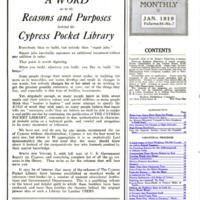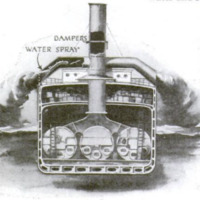New technology designed to make cargo ships less visible from a distance
Item
-
Title (Dublin Core)
-
New technology designed to make cargo ships less visible from a distance
-
Article Title and/or Image Caption (Dublin Core)
-
That Betraying Column of Smoke Force It Down tn the Water
-
extracted text (Extract Text)
-
THE bridge of an ordinary carga vessel rises ou height
of from 33 to 35 feet above sea-level, and towers above
the horizon visible to the observer on the bridge of a sub-
marine at a distance of ten miles. As a matter of fact,
however, cargo ships of the average type usually be-
tray their presence at a very
much greater distance because
of the smoke that belches from
their smokestacks.
As early as thirty years ago,
Sir Alfred Yarrow, the famous
English naval architect, originat-
ed a method for driving the smoke
from steamships downward. The
necessity of giving greater protec-
tion to cargo ships passing
through the danger zone during
the war caused a revival of inter-
est in that plan, and extensive ex-
periments were made proving the
effectiveness of the method.
From the base of the smoke-
stack, at an elevation of about six
feet above the deck, horizontal
ducts are carried to the gunwales
on each side of the ship. The
outer half of these ducts _
slope down at an angle
of about 45 degrees.
Normally these ducts are
closed by dampers on
the inside, close to the
smokestack. On the in-
side of each duct, just
above the knee, nozzles
eject a cone of water
spray under a pressure
of 150 pounds to the
square inch. When it
is desired to divert the
smoke, the damper of
the duct on the lee side of the ship is
opened, the damper of the smokestack
is closed, and the water supplying the
nozzle in the respective duct turned on.
The cold water cools the gases, and
this and the force of the spray cause
the smoke and gases to descend to the
‘water and settle.
-
Language (Dublin Core)
-
eng
-
Date Issued (Dublin Core)
-
1919-01
-
pages (Bibliographic Ontology)
-
54
-
Rights (Dublin Core)
-
Public domain (Google digitized)
-
Archived by (Dublin Core)
-
Davide Donà
-
Marco Bortolami (editor)
 Popular Science Monthly, v. 94, n. 1, 1919
Popular Science Monthly, v. 94, n. 1, 1919
 Screenshot (414).png
Screenshot (414).png
